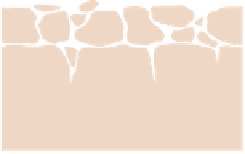Geology Reference
In-Depth Information
Soil horizons
O
Humus
A
Zone of leaching
(topsoil)
B
Zone of accumulation
(subsoil)
C
Weathered parent
material (bedrock)
a
Soils are made up mostly of minerals and rock fragments derived
by weathering, air, water, and organic matter. Most of the organic
matter is humus.
Gradational contact
Fresh parent material
(bedrock)
◗
Figure 6.10
The Composition of Soil and Soil Horizons
b
The soil horizons of a fully developed soil.
residue accumulates over the granite and is converted to soil,
the soil thus formed is residual. In contrast,
transported soils
develop on weathered material that was eroded and carried to
a new location, where it is altered to soil.
Observed in vertical cross section, soil consists of distinct
layers or
soil horizons
that differ from one another in tex-
ture, structure, composition, and color (Figure 6.10b). Start-
ing from the top, the soil horizons are designated O, A, B,
and C, but the boundaries between horizons are transitional.
Because soil formation begins at the surface and works
downward, horizon A is more altered from the parent mate-
rial than the layers below.
Horizon O, which is only a few centimeters thick, con-
sists of organic matter. The remains of plant materials are
clearly recognizable in the upper part of horizon O, but its
lower part consists of humus.
Horizon A, called
topsoil
, contains more organic matter
than horizons B and C below. It is also characterized by
intense biological activity because plant roots, bacteria,
fungi, and animals such as worms are abundant. Threadlike
soil bacteria give freshly plowed soil its earthy aroma. In soils
developed over a long period of time, horizon A consists
mostly of clays and chemically stable minerals such as quartz.
Water percolating down through horizon A dissolves soluble
minerals and carries them away or downward to lower levels
in the soil, a process called
leaching.
Accordingly, horizon A is
also referred to as the
zone of leaching.
Horizon B, or
subsoil
, contains fewer organisms and less
organic matter than horizon A (Figure 6.10b). Horizon B
is also known as the
zone of accumulation
because soluble
minerals leached from horizon A accumulate as irregular
masses. If horizon A is eroded, leaving horizon B exposed,
plants do not grow as well, and if it is clayey, it is harder
when dry and stickier when wet than other soil horizons.
Horizon C has little organic matter and consists of par-
tially altered parent material grading down into unaltered
parent material (Figure 6.10b). In horizons A and B, the
composition and texture of the parent material have been so
thoroughly altered that it is no longer recognizable. In con-
trast, rock fragments and minerals of the parent material
retain their identity in horizon C.
Climate is the single most important factor in soil origins,
but complex interactions among several factors account
for soil type, thickness, and fertility (
◗
Figure 6.11). A very
general classifi cation recognizes three major soil types char-
acteristic of different climatic settings. Soils that develop in
humid regions such as the eastern United States and much
of Canada are
pedalfers,
a name derived from the Greek
word
pedon
, meaning “soil,” and from the chemical symbols
for aluminum (Al) and iron (Fe) (
◗
Figure 6.12a). Because
these soils form where abundant moisture is present, most
of the soluble minerals have been leached from horizon A.
Although it may be gray, horizon A is commonly dark
because of abundant organic matter, and aluminum-rich
clays and iron oxides tend to accumulate in horizon B.
Soils found in much of the arid and semiarid west-
ern United States, especially the Southwest, are
pedocals
.
Pedocal derives its name, in part, from the fi rst three letters















































Search WWH ::

Custom Search